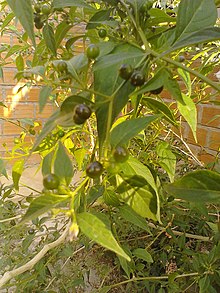| Capsicum cardenasii | |
|---|---|

| |
| C. cardenasii plant with immature fruit | |
|
Scientific classification
| |
| Kingdom: | Plantae |
| Clade: | Tracheophytes |
| Clade: | Angiosperms |
| Clade: | Eudicots |
| Clade: | Asterids |
| Order: | Solanales |
| Family: | Solanaceae |
| Genus: | Capsicum |
| Species: | C. cardenasii
|
| Binomial name | |
| Capsicum cardenasii Heiser & P.G.Sm.
| |
Capsicum cardenasii is a plant species in the genus Capsicum and the family Solanaceae. It is a diploid with 2n=2x=24. It is a member within the C. pubescens complex, a group of closely related Capsicum species. It is closely related to C. eximium. It is native to the Andes, and it can be found in Bolivia and Peru. [1] The native name is ulupica. [2]
Vegetative characteristics
Capsicum cardenasii, like most members of the Pubescens complex, is a perennial plant that develops woody stems. The plant can grow up 2–3 feet high with a width of 1-1.5 feet. The leaves are narrow, lanceolate and pubescent. Plants generally produce between 1 and 2 flowers at the internodes. The petioles grow erect and have campanulate, pendant flowers. [3] The corolla is white and purple colored. [2] The plant produces small, fleshy, red fruit. It is likely the wild ancestor of rocoto peppers. [4]
The plant requires a cool, freeze free environment and long growing season similar to its native environment in the Andes. [1]
Reproduction
After fertilization C. cardenasii develops small round red berries, sometimes referred to as chiltepins. The fruits contain a small number of seed. The fruit are pungent, near 30 000 SHU ( Scoville Heat Units), making them quite spicy.[ citation needed]
Capsicum cardenasii is self-incompatible, and exhibits unilateral incompatibility with species outside the pubescens clade. [5]
Uses
Its primary use is as a spice. Many wild Capsicums exhibit disease resistance of interest to plant breeders. C. cardenasii has been shown to be resistant to tobacco mosaic virus (TMV), and there is a possibility that one day this resistance may be transferred to other capsicum species through breeding. [2]
References
- ^ a b "Peppers: History and Exploitation of a Serendipitous New Crop Discovery". Hort.purdue.edu. Retrieved 2016-01-29.
- ^ a b c Pickersgill, Barbara (1997-07-01). "Genetic resources and breeding of Capsicum spp". Euphytica. 96 (1): 129–133. doi: 10.1023/A:1002913228101. ISSN 0014-2336. S2CID 34886799.
- ^ Brian M. Walsh; Sara B. Hoot (2001). "PHYLOGENETIC RELATIONSHIPS OF CAPSICUM (SOLANACEAE) USING DNA SEQUENCES FROM TWO NONCODING REGIONS: THE CHLOROPLAST atpB-rbcL SPACER REGION AND NUCLEAR waxy INTRONS" (PDF). Int. J. Plant Sci. 162 (6): 1409–1418. doi: 10.1086/323273. S2CID 3233466. Retrieved 17 March 2022.
- ^ "Taxonomy - GRIN-Global Web v 1.9.4.2". Npgsweb.ars-grin.gov. Retrieved 2016-02-20.
- ^ Onus, A. Naci; Pickersgill, Barbara (2004-08-01). "Unilateral Incompatibility in Capsicum (Solanaceae): Occurrence and Taxonomic Distribution". Annals of Botany. 94 (2): 289–295. doi: 10.1093/aob/mch139. ISSN 0305-7364. PMC 4242164. PMID 15229125.
| Capsicum cardenasii | |
|---|---|

| |
| C. cardenasii plant with immature fruit | |
|
Scientific classification
| |
| Kingdom: | Plantae |
| Clade: | Tracheophytes |
| Clade: | Angiosperms |
| Clade: | Eudicots |
| Clade: | Asterids |
| Order: | Solanales |
| Family: | Solanaceae |
| Genus: | Capsicum |
| Species: | C. cardenasii
|
| Binomial name | |
| Capsicum cardenasii Heiser & P.G.Sm.
| |
Capsicum cardenasii is a plant species in the genus Capsicum and the family Solanaceae. It is a diploid with 2n=2x=24. It is a member within the C. pubescens complex, a group of closely related Capsicum species. It is closely related to C. eximium. It is native to the Andes, and it can be found in Bolivia and Peru. [1] The native name is ulupica. [2]
Vegetative characteristics
Capsicum cardenasii, like most members of the Pubescens complex, is a perennial plant that develops woody stems. The plant can grow up 2–3 feet high with a width of 1-1.5 feet. The leaves are narrow, lanceolate and pubescent. Plants generally produce between 1 and 2 flowers at the internodes. The petioles grow erect and have campanulate, pendant flowers. [3] The corolla is white and purple colored. [2] The plant produces small, fleshy, red fruit. It is likely the wild ancestor of rocoto peppers. [4]
The plant requires a cool, freeze free environment and long growing season similar to its native environment in the Andes. [1]
Reproduction
After fertilization C. cardenasii develops small round red berries, sometimes referred to as chiltepins. The fruits contain a small number of seed. The fruit are pungent, near 30 000 SHU ( Scoville Heat Units), making them quite spicy.[ citation needed]
Capsicum cardenasii is self-incompatible, and exhibits unilateral incompatibility with species outside the pubescens clade. [5]
Uses
Its primary use is as a spice. Many wild Capsicums exhibit disease resistance of interest to plant breeders. C. cardenasii has been shown to be resistant to tobacco mosaic virus (TMV), and there is a possibility that one day this resistance may be transferred to other capsicum species through breeding. [2]
References
- ^ a b "Peppers: History and Exploitation of a Serendipitous New Crop Discovery". Hort.purdue.edu. Retrieved 2016-01-29.
- ^ a b c Pickersgill, Barbara (1997-07-01). "Genetic resources and breeding of Capsicum spp". Euphytica. 96 (1): 129–133. doi: 10.1023/A:1002913228101. ISSN 0014-2336. S2CID 34886799.
- ^ Brian M. Walsh; Sara B. Hoot (2001). "PHYLOGENETIC RELATIONSHIPS OF CAPSICUM (SOLANACEAE) USING DNA SEQUENCES FROM TWO NONCODING REGIONS: THE CHLOROPLAST atpB-rbcL SPACER REGION AND NUCLEAR waxy INTRONS" (PDF). Int. J. Plant Sci. 162 (6): 1409–1418. doi: 10.1086/323273. S2CID 3233466. Retrieved 17 March 2022.
- ^ "Taxonomy - GRIN-Global Web v 1.9.4.2". Npgsweb.ars-grin.gov. Retrieved 2016-02-20.
- ^ Onus, A. Naci; Pickersgill, Barbara (2004-08-01). "Unilateral Incompatibility in Capsicum (Solanaceae): Occurrence and Taxonomic Distribution". Annals of Botany. 94 (2): 289–295. doi: 10.1093/aob/mch139. ISSN 0305-7364. PMC 4242164. PMID 15229125.